Plants of Chester Creek
The Chester Creek Trail is home to hundreds of species of wildflowers, vines, shrubs, trees, and grasses with a blooming season that extends from March through October.
Learn more about the biodiversity and seasons of Chester Creek in the attachments below.
**A huge thank you to John “Mac” MacFarland for putting this together and sharing your vast ecological knowledge!!
Common Early Spring Plants
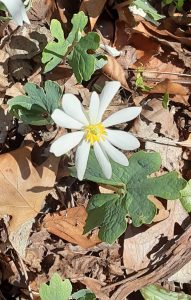
Bloodroot
(Sanguinaria canadensis)
The leaves and flowers sprout from reddish rhizome containing a bright orange/red sap, which is the reason for the genus Sanguinaria, meaning “bloody” in Latin. It was used as a red dye by tribes living in areas of its growth. It produces a single basal leaf with five to seven lobes that enclose the white flower until it blooms. Every morning it opens and at night it closes. It is insect pollinated but produces no nectar.
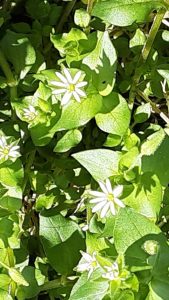
Common Chickweed
(Stellaria media)
This species is grown as a vegetable crop and ground cover for both human and poultry consumption, thus its name. It is edible and nutritious and often used raw in salads. Its genus name is derived from the Latin meaning “star”. Flowers are white and small with five very deeply lobed petals. Over the years, it has been used medicinally for iron-deficiency anemia as well as skin diseases and bruises.
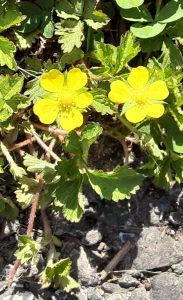
Common Cinquefoil
(Potentilla simplex)
This species is a familiar plant with prostrate stems that root at nodes, with five- petaled yellow flowers, and five-parted palmately pinnate leaves arising from separate stalks. Its name is derived from the Latin, “cinque,” meaning five. Its presence is an indicator of impoverished soil. Insects pollinate it, but not so much by butterflies. Rabbits and groundhogs eat its foliage, which is also used in salads.
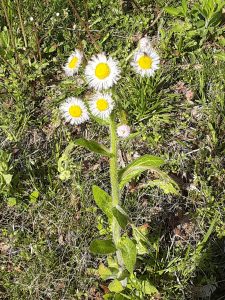
Common Fleabane
(Erigeron philladelphicus)
This species is native to North America and is a member of the daisy family. Introduced to Europe and Asia, it is considered an invasive species there. It can be found growing along roadsides, in fields, in thickets, and in open woods. The flower heads are borne in arrays of as many as 35 heads. Each head may sometimes contain as many as 400 pink or white ray florets surrounding yellow disc florets.

Common Spicebush
(Lindera benzoine)
Common spicebush is a member of the laurel family. Its leaves, buds, and new growth twigs can be made into a tea. The fruits can be dried, ground, and used as an allspice substitute. Local tribes used it as a treatment for multiple ailments. Many animals feed on the leaves, twigs, and berries, including deer, game birds, and songbirds. When crushed, its leaves emit a spice-like aromatic odor, thus its name.
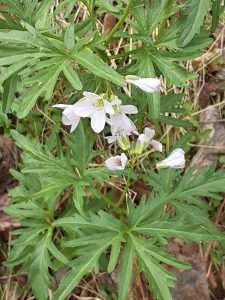
Cut Leaved Toothwort
(Caddamine concagtentata)
The roots of this plant can be washed, chopped, and ground in vinegar to be used as a horseradish substitute. Its native habitats include rich woods, wooded bottomland, limestone outcrops, and rocky banks and bluffs. The leaves are on long petioles, deeply palmately dissected into five toothed segments. Its white to pinkish flowers are held above the foliage in a spike, which ripens into an elongated pod.

Eastern Redbud
(Cercis canadensis)
The flowers of this southern shrub are light to dark magenta pink in color and appear in clusters on bare stem before the leaves. Long-tongued bees pollinate the flowers. The leaves are alternate, simple, and heart shaped, long and wide, thin and papery, and may be slightly hairy below. The flowers can be eaten fresh or fried. Tribes in the area consumed the flowers raw or boiled, and ate the roasted seeds.
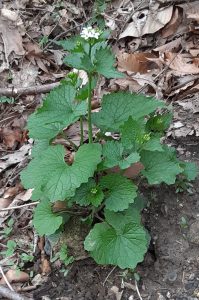
Garlic Mustard
(Allaria petiolata)
This member of the mustard family is a highly invasive species introduced by European settlers. In the first year of growth, plants form clumps of round wrinkled leaves that when crushed smell like garlic. The plants flower the next spring producing cross-shaped white flowers in dense clusters. The crushed seeds are used as a mustard substitute. It is one of the oldest spices used in Europe.
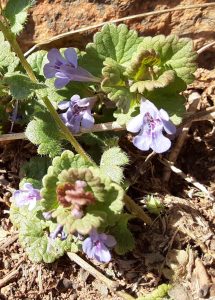
Gill-Over-The-Ground
(Glechoma hederacea)
This member of the mint family is also called Ground-ivy, Creeping Charlie, and Run-Away-Robin. It thrives in moist shaded areas, but also tolerates sun. It thrives in lawns and around buildings as it survives mowing. In the United States, it is considered an invasive species. But, in Europe it was cultivated and used in the brewing of ale before the current use of hops, as well as a medicinal compound.
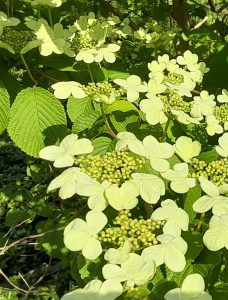
Hobblebush
(Viburnum lantanoides)
This perennial shrub has pendulous branches that take root where they touch the ground forming obstacles, which easily trip walkers-hence the common name. It grows to heights of six feet and has opposite large heart-shaped leaves. The flowers form large, flat clusters and are very white. The Algonquin reportedly rubbed its mashed leaves on the head to treat migraines. The Iroquois as a blood medicine.
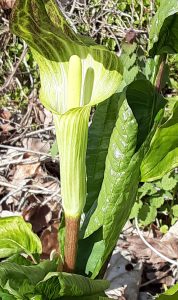
Jack-In-The Pulpit
(Arisaema atrorubens)
This species is distinctive with its three-part leaves and flowers contained in a spadix that is covered by a hood. The oxalic acid found in the plant is poisonous if ingested. However, if cooked, it can be eaten as a root vegetable. If sliced and dried, it can be eaten like potato chips, or ground into flour. The oxalate crystals give it a peppery flavor. It has been used to treat sore eyes, rheumatism, and snake bites.
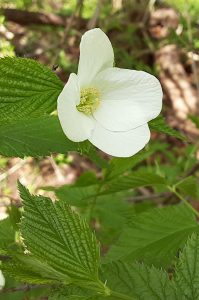
Jetbead
(Rhodotypos scandens)
This species is a deciduous shrub in the Rose family. It is native to Asia. It grows to a height of five feet with opposite simple ovate leaves. The flowers are white and have four petals. The fruit is a cluster of one to four shiny jet-black berries. These are highly toxic, and may be fatal if eaten. It was introduced into the ornamental nursery trade around 1866.
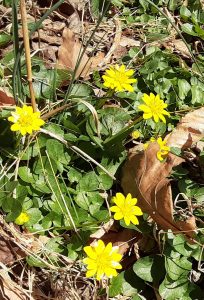
Lesser Celandine
(Ficaria verna)
This species is a member of the Buttercup family, and contains a compound known as protoanemonin. Contact with crushed leaves can cause itching, rashes, or blistering on the skin. Ingesting the toxin can cause nausea, vomiting, dizziness, spasms, and paralysis. Cooking of the plant eliminates its toxicity. It is also known as Pilewort because it has historically been used to treat piles (hemorrhoids).
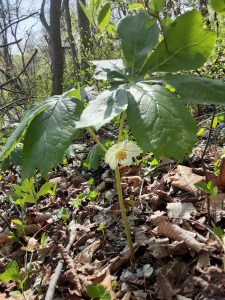
Mayapple (Mandrake)
(Podophyllum petatum)
These woodland plants typically grow in colonies derived from a single root. The stems grow to 15 inches tall with palmately lobed umbrella-like leaves. Flowering stems produce a pair of leaves with flowers found in the axils of the leaves. The flowers are white with six to nine petals and mature into a yellow fleshy fruit. All parts of the plant are poisonous, including the fruit until it ripens and turns yellow.
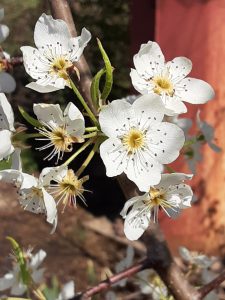
Pin (Fire) Cherry
Prunus pennsylvanica
This species may grow to heights of up to fifty feet. Neither its soft wood nor fruit have any commercial value, but the wood can be used as firewood or chips, and the fruit can be used for jams, jellies, and preserves. It can regenerate by both seed and sprout. Seeds accumulate over prolonged periods in the soil and may remain viable for a hundred years. Flowers occur in small groupings of five to seven individuals.
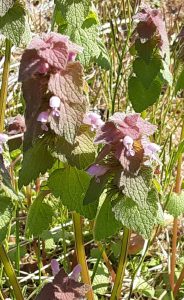
Purple Dead-Nettle
(Lamium purpureum)
Like all mints, this species is characterized by its square stem. It is native to Europe and Asia, so, as an escape becomes invasive. Though superficially similar to species of true nettles in appearance, it does not sting, hence the name. It is extremely beneficial to pollinating bees. Young plants can be used in salads or finely chopped for sauces. Herbalists use it for many remedies including as a salve for itchy skin.
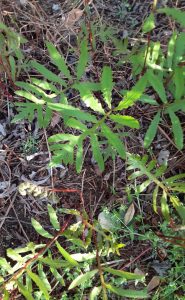
Sensitive Fern
(Onclea sensibilis)
This species derives its name from its sensitivity to frost, the fronds dying quickly when first touched by it. It has remained essentially unchanged over millions of years as exhibited by a fifty-seven million year old fossil of Paleocene epoch flora. It propagates by both spore dispersion and rhizome growth. It is cultivated as an ornamental plant in gardens, but can become aggressive if not controlled.

Slender Speedwell
(Veronica filiformis)
This species is a native of Turkey, introduced to the United Kingdom in 1808 and first reported in the United States as an escape in 1838. The corolla is four-lobed and bluish with a white tip with the top lobe being the largest. In Ireland, it was sewn into the clothing of travellers for good luck. It reproduces from separated sections of stem and rhizome, so is easily dispersed, especially by mowing.
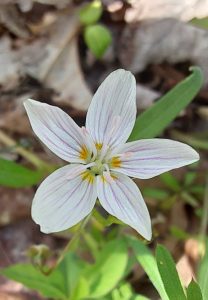
Spring Beauty
(Claytonia virginica)
This species honors the colonial Virginian botanist John Clayton. It is a trailing perennial plant, overwintering through a tuberous root. Its individual flowers bloom for only three days. Its seeds are released from a capsule fruit and easily spread by insects. The Iroquois would eat the raw roots, believing they prevented conception. The leaves can be cooked in salted water, although not choice eating.
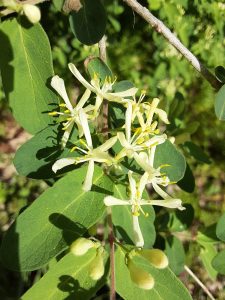
Tartarian Honeysuckle
(Lonicera tatarica)
This species is native to Siberia and was introduced to the United States as an ornamental plant in 1752. Of cats that do not respond to catnip, one third respond to its aromatic wood. Ingestion of the berries by humans causes diarrhea, vomiting, and abdominal pain, but not death. The berries are, however, beneficial to wildlife. Birds spread its seeds through their droppings. The flowers have a sweet smell.
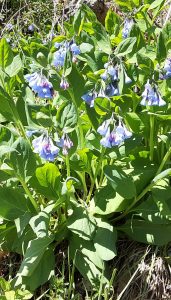
Virginia Bluebells
(Mertensia virginica)
This species is a spring ephemeral plant with bell-shaped sky-blue flowers. The flowers have five petals that are fused into a tube. Bees can pollinate this flower, but because of its funnel shape they must hover, making them rare pollinators. Butterflies are the most common pollinators as they can perch on the edges. Early tribal societies used it for medicines, but there is no scientific proof that they work.
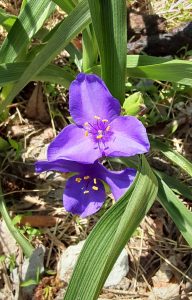
Virginia Spiderwort
(Tradescantia virginina)
This species is a perennial herbaceous plant with alternate, simple leaves, on tubular stems. The flowers can be blue, purple, magenta, or white. It prefers moist soils, but can adapt to drier garden soils. It is a southern plant that has escaped in the north, as it is commonly grown in gardens, due to its attractive flowers. As an escape, it is found growing wild along roadsides and railway lines.
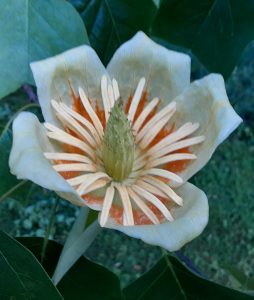
Yellow (Tulip) Poplar
(Liriodendron tulipfera)
This species of tree with its characteristic tulip like flowers can grow to heights of one hundred fifty feet. The largest tree is Eastern North America is a Tulip Poplar in the Great Smoky Mountains that is one hundred ninety-two feet tall. It is valued by landscapers for its use as a shade tree, for its wood as building material due to its resistance to termites, and as a sculpting medium for wood carvers.

Yellow Trout Lily
(Erythronium americanum)
This species derives its name from its gray-green leaves mottled with brown or gray, which allegedly resemble the coloring of Brook Trout. It blooms in early spring before the trees growing above them develop leaves. This time allows them unobstructed access to sunlight for photosynthesis and time to grow when soil nutrient levels are highest. The flowers close at night and open again in the sunlight.
Common Autumn Plants
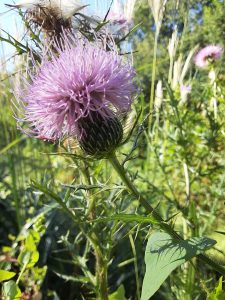
Pasture Thistle
(Cisium pumilum)
This is a biennial plant that grows up to forty inches in height on a typically hairy stem. It blooms only once before dying. Its leaf blades are slender with stout very long spines and are up to twelve inches in length. The flower heads are sweetly scented and are pink, purple, or even white in color with no ray florets. It has the largest flowers of all the local thistle species.
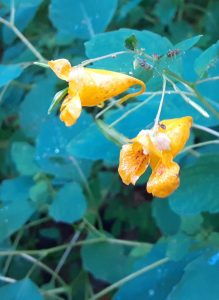
Spotted Touch-Me-Not
(Impatiens capensis)
This orange flower is covered with red spots. It is also called Orange Jewelweed. It may be found growing alongside its common relative, Yellow Jewelweed. They both take their name from the characteristic that, when held under water, the leaves look like silver. Its other name comes from its seeds exploding from their capsules when touched. Juice from its stem can be an antidote for bee stings and poison ivy.
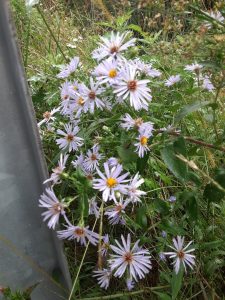
Purple-Stemmed Aster
(Symphyotrichum puniceum)
A hairy purple stem is a characteristic of this aster. Its flowers consist of yellow to cream-colored disc florets surrounded by dark blue to purple ray florets. Its disc florets become pink or purple with maturity. It seldom forms dense colonies but is rather found as small clusters or scattered individuals. Various Native American tribes have found medicinal uses for this plant to include curing colds and fevers.
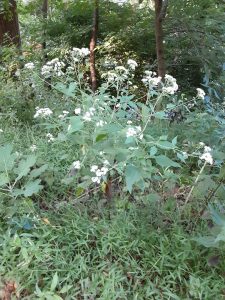
White Snakeroot
(Argeratina altissima)
This plant contains the toxin tremetol. When consumed by cattle, the meat and milk become contaminated with the toxin. When humans consume the meat or milk, it may lead to death. This plant was responsible for the thousands of deaths of the babies of western migrating pioneers., who unwittingly grazed their cows on it. It was complicit in the death of Nancy Hanks Lincoln, mother of the future president.
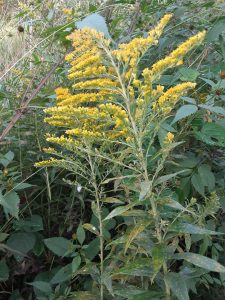
Tall Goldenrod
(Solidago altissima)
This perennial member of the Goldenrod family grows to a height of six feet and can be found growing in open fields, meadows, roadsides, along railroads, and the edges of woodlands. Its flowers are arranged in branching clusters of numerous small, stalked yellow flower heads. Its leaves are all alternate with a rough upper surface and a densely hairy underside. Its stems also exhibit this hairy characteristic.
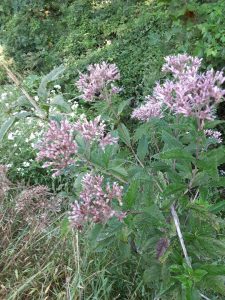
Spotted Joe-Pye-Weed
(Eupatorium maculatum)
This perennial plant grows as high as six and one-half feet in height. Stems are sometime completely purple and sometimes green with purple spots. Each plant produces numerous rose-purple flower heads with eight to twenty-two disc flowers but no ray flowers. Maculatum means spotted. It is named after Joe Pye, who was a Native American herbalist that used local plants to cure a variety of illnesses.
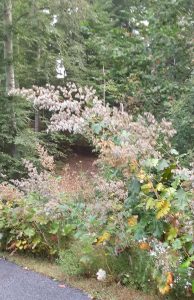
Plume Poppy
(Macleaya cordata)
This five-seeded poppy is used ornamentally. It is native to China and Japan. It is a large perennial that grows up to eight feet in height. It has olive green heart-shaped leaves and buff white flowers on airy panicles during summer. It self-seeds readily and easily becomes invasive. It was originally bred at Kew Gardens in England. It is named for Alexander McLeay (1767 to 1848), a British entomologist.
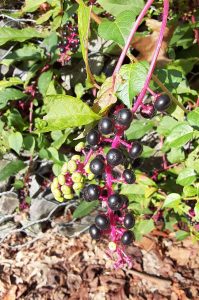
Pokeweed
(Phytolacca americana)
This is a poisonous perennial plant that grows up to ten feet in height. It has simple leaves on green, red, or purplish stems. The flowers are green to white, followed by berries that ripen to purple or almost black and are a food source for many species of songbirds. Native Americans used its berries for a purple dye. In early Spring, shoots and leaves are edible with proper cooking, but later become poisonous.

Porcelain Berry
(Ampelopsis glandulosa)
This is an ornamental plant that is native to temperate areas of Asia. Due to its leaves, it is early confused with species of grapes. It is a deciduous, woody, perennial climbing vine with flowers and tendrils opposite the palmate three to five lobed leaves that are white beneath. It climbs by means of tendrils. Its small green-white flowers become green, blue, purple, pink, yellow, or black berries.
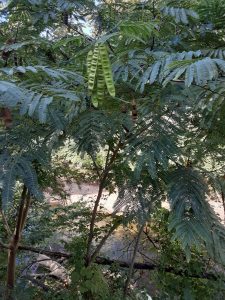
Persian Silk Tree
(Albizia julibrissin)
This tree is native to southwestern and eastern Asia. It is named after an Italian nobleman, Filippo degli Albizzi, who introduced it to Europe in the mid-18th century. It is a deciduous tree that grows up to fifty feet in height and whose canopy is shaped like a canopy. The leaves are fern-like and feathery in appearance. The dark pink flowers are showy and wispy. Its six-inch seed pods are flat and linear.
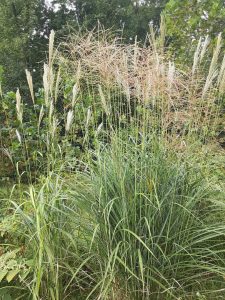
Chinese Silver Grass
(Miscanthus sinensis)
This grass is native to eastern Asia. It made an entrance into occidental gardens about a century ago due to its spectacular feathery plums that tower above their graceful arching foliage. It grows in distinctive clumps and can be up to twelve feet in height. It has been bred to produce various erect, airy, plumed seed heads from pale silver to purplish-red in color depending on the variety.

Christmas Fern
(Polystichum acrostichoides)
This is a perennial, evergreen fern native to Eastern North America. Its common name derives from the evergreen fronds, which are often still green at Christmas. Also each pinnae on a frond when held correctly looks like Santa Claus in his sled. It grows in a clump with its fronds arising from a central point. It produces fertile fronds that bear light brown spores on the edges of the upper pinnae.

Arrow-Leaved Tear Thumb
(Persicaria sagittata)
This is an annual herb with prickles along the stem. It can be up to six feet in length and often climbs over adjacent vegetation. Leaves can be heart-shaped or arrowhead-shaped. Flowers vary from white to pink and are found in clusters that are spherical or elongated in shape. They are replaced by varied colored fruit in similar clusters.
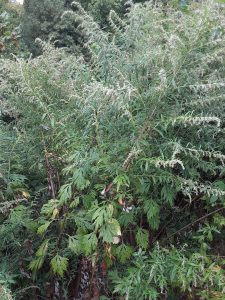
Mugwort
(Artemisia ulgaris)
This is a tall perennial plant growing up to two and one-half feet in height. It spreads through dispersal of root rhizome fragments rather than seed dispersal. The leaves are dark green, pinnate and sessile, with dense, white hairs on the underside. The erect stems are grooved and have a red-purplish tinge. It has rather small florets with yellow or dark red petals.

Bur Cucumber
(Sicyos angulatus)
This annual herb is a climbing vine that can be up to twenty-five feet in length. The alternate leaves can be up to eight inches in length with three to five palmate lobes. The stems are furrowed and quite hairy. The plant is monoecious and produces both staminate (male) and pistillate (female) five-petal flowers on the same plant. They climb from one location to another using numerous tendrils.
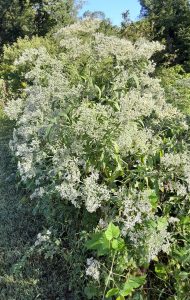
Late Flowering Thoroughwort
(Eupatorium serotinum)
This plant is also known as Late Boneset due to its fall blooming season. Like other members of Eupatorium it grows up to nearly seven feet in height, but its leaves are stalked on purple stems. It has dense inflorescences containing a large number of tiny white flower heads with nine to fifteen disc florets but no ray florets. It is insect pollinated unlike other species of Eupatorium that are pollinated by the wind.
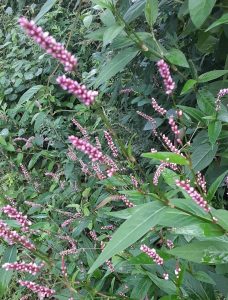
Pennsylvania Smartweed
(Polygonum pennsylvanicum)
This plant is in the buckwheat family. It may grow up to six and one-half feet in height. Its lance-shaped leaves reach three-quarters of an inch in length. Its inflorescences grow at the top of the stem and from the leaf axils. The flowers are pinkish in color. This plant is an important part of the habitat for birds that feed on its seeds. Several Native American tribes have various medicinal uses for it.

Horseweed
(Erigeron canadensis)
This annual plant grows up to five feet in height on sparsely hairy stems. Its leaves are unstalked, slender, up to four inches in length, with a coarsely toothed margin. They grow in an alternate spiral up the stem. The flowers are produced in dense inflorescences with each individual flower having a ring of white or pale purple ray florets and a center of yellow disc florets. The seeds are tipped with a white down.

Small White Aster
(Aster vimineus)
This is one of the many species within the Aster family. Aster is derived from the Greek and Latin words for “star” just as in asteroid. This name comes naturally from their many ray flowers around a central cluster. Small white daisy-like flowers that are crowded closely together along purple stems characterize this species. It may grow as high as five feet in fields and meadows with partial shade.